Today we’re going to look at how to avoid playing the Big Blind short-stacked like a scared child.
Players can get stuck in this spot playing too passive a game, especially when they get short stacked. The trouble is calling on the flop puts us in even tougher spots on later streets where our opponent can pummel us, especially if there’s some ICM pressure to boot.
The beauty of GTOTrainer is that you can deep dive tough spots in seconds.
What takes longer is pulling out all the reels of gold that GTOTrainer spins out. We’re here to help with our GTOTrainer Strategy Guides.
We’ll tease out the best ways to implement our GTO solutions into real-world play.

These stack depths also tend to occur a lot in the mid to late stages of an MTT, in which case there may be ICM effects further restricting what Big Blind can do in defence, especially if they are the effective stack.
These kinds of spots are incredibly important to get right, as there’s just so much equity flying around in late-stage MTTs!
We’ve picked an even tougher spot to dive into today - where we’re facing an open from UTG, who will obviously have a strong range coming in. We’ll deep dive this spot to find out how to maneuver against that range when low on chips, and see how the equities stack up.
One thing we’ll certainly want to know early on is which non-pair hands do best to the flop for the Big Blind?
We want to peek into how to play on the average flop in this write-up, since that should give us the most broad take-aways for in-game play. As it turns out even the average board in this spot sees UTG having a big equity lead, with BB holding only 36% of the equity.
Some of these average boards include the following flops
We’ll go with Jh6d4c this time around, so take a deep breath, and let’s dive.
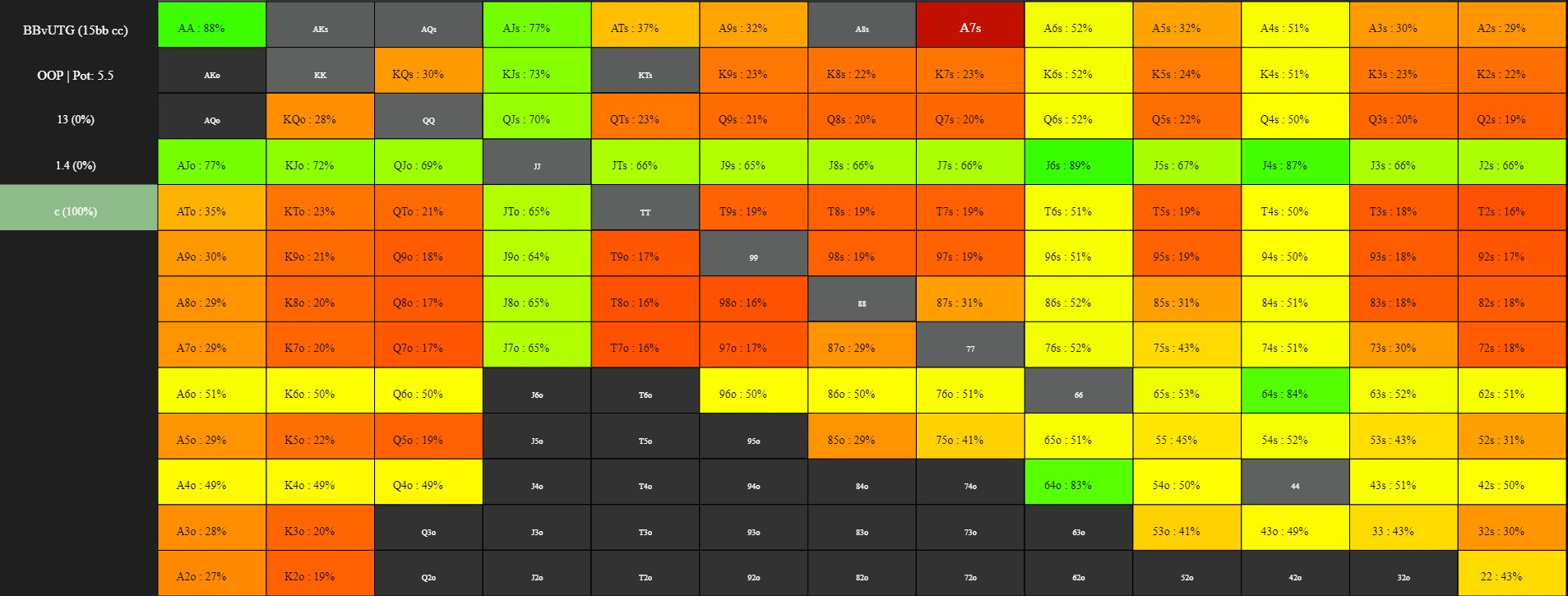
What’s interesting/key to notice about BB’s equity first to act is that the non-pair hands with the best equity are going to be draws such as the open-enders 75 and 53, at the absolute bottom of our defending range pre. Top card holdings like ATs, A5s and KQs also retain a good chunk of equity.
As you can see on the left, BB should check his range here.

As you can see above, UTG is absolutely stomping in equity terms here, doing well with all parts of their range except perhaps the weakest Kxs, Qxs and T9s.

Whenever you’re in this spot UTG you are laughing, provided you’re willing to bet. Most players won’t fire back at you nearly enough, so there’s even more value in betting in-game.
The solver prefers a third pot but also uses a half-pot sizing in some cases, preferring a tiny bet sizing of under 20% with holdings such as sets, and sometimes with overpairs and big Ax hands as well as suited broadways.
The fascinating question about this flop is what is the Big Blind’s optimal strategy, since they are the player in the tough spot.
It’s a pretty common tendency in today’s game for players to simply play quite passive in this spot, and try to call down / get to showdown with mid-strength holdings, aware of the positional and equity disadvantage which they are at.
The trouble is that this just creates even tougher spots for ourselves down the streets.
As we’ll see from GTOTrainer’s solutions, we can actually take a much more aggressive line than this with parts of our range, and this will work out better in terms of claiming equity.
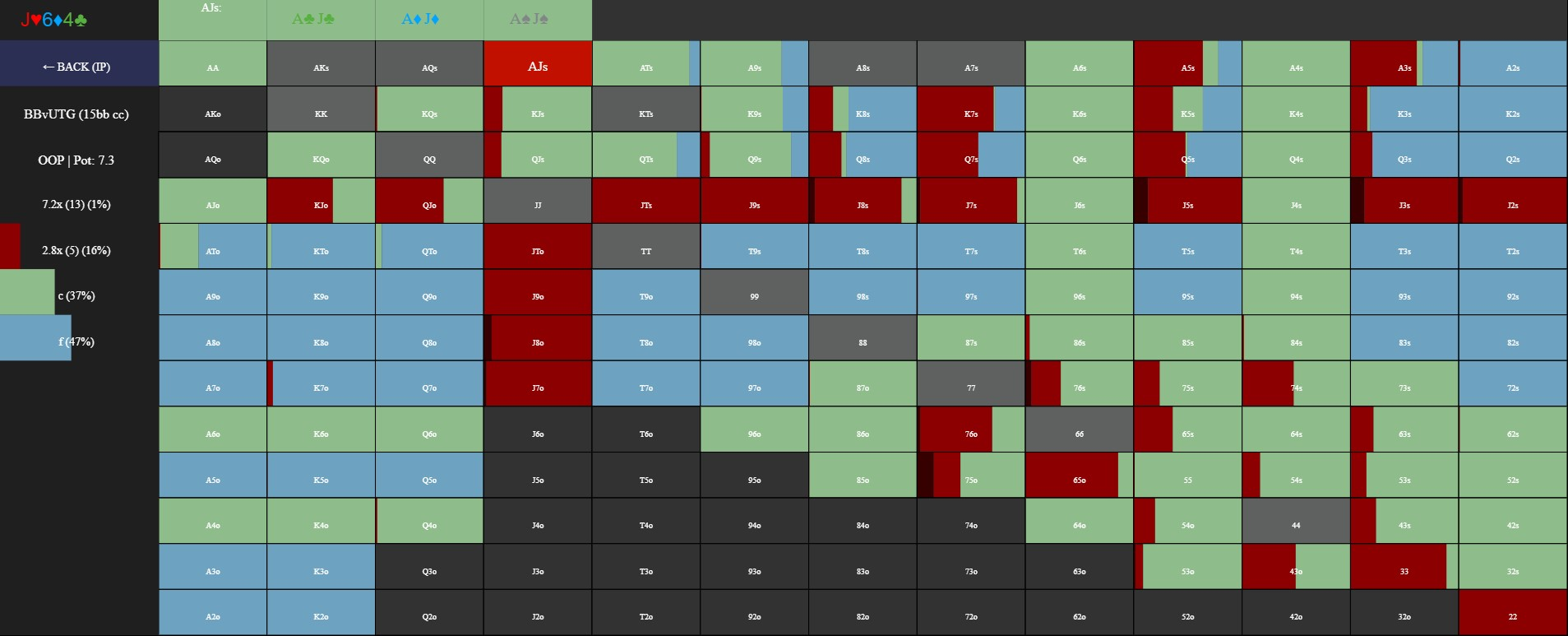
Whilst GTOTrainer does want us to fold a good amount of the time here (47%), when we don’t fold we are actually check-raising around a third of the remaining time.
We are supposed to check/call with a lot of our 6x and 4x holdings, as well as lots of our gutshots like 52s and open-enders such as 53o. Some of our biggest Jx hands are still a flat call, such as AJs and KJs, with AA used as a trap. We also slowplay our two pair combos, and we don’t have any sets since all those pairs shove pre-flop.
The interesting part comes in looking into our check-raising range however, when we note that we are supposed to check-raise 2.8x (so around 5bb of our remaining 14bb) with a lot of our midstrength Jx hands and just commit now, as well as some of our worst 6x hands which have backdoor straight draws (76o, 65o).
Our best bluff check-raises are A-high backdoor flush draws which also block pairs (A5s, A3s), a few Qxs and Kxs which block pairs (K7s, Q7s) and interestingly our baby pairs and 43o (33, 22) which actually have quite a good amount of equity against UTG’s range bet on the flop and which benefit from playing fast as they can’t get to showdown easily with a passive line.
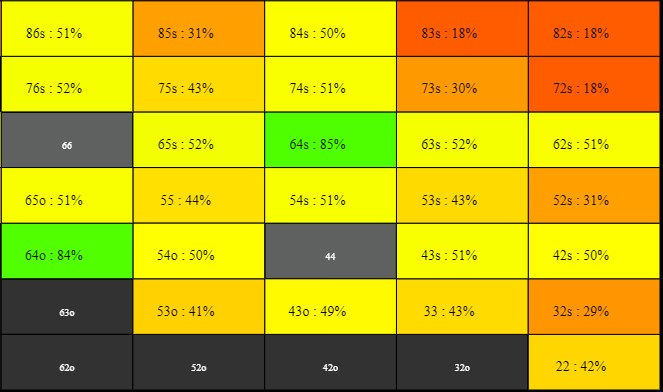
Let’s look next at how BB should proceed with their check/calling range, and with their check-raising range on a low turn card.
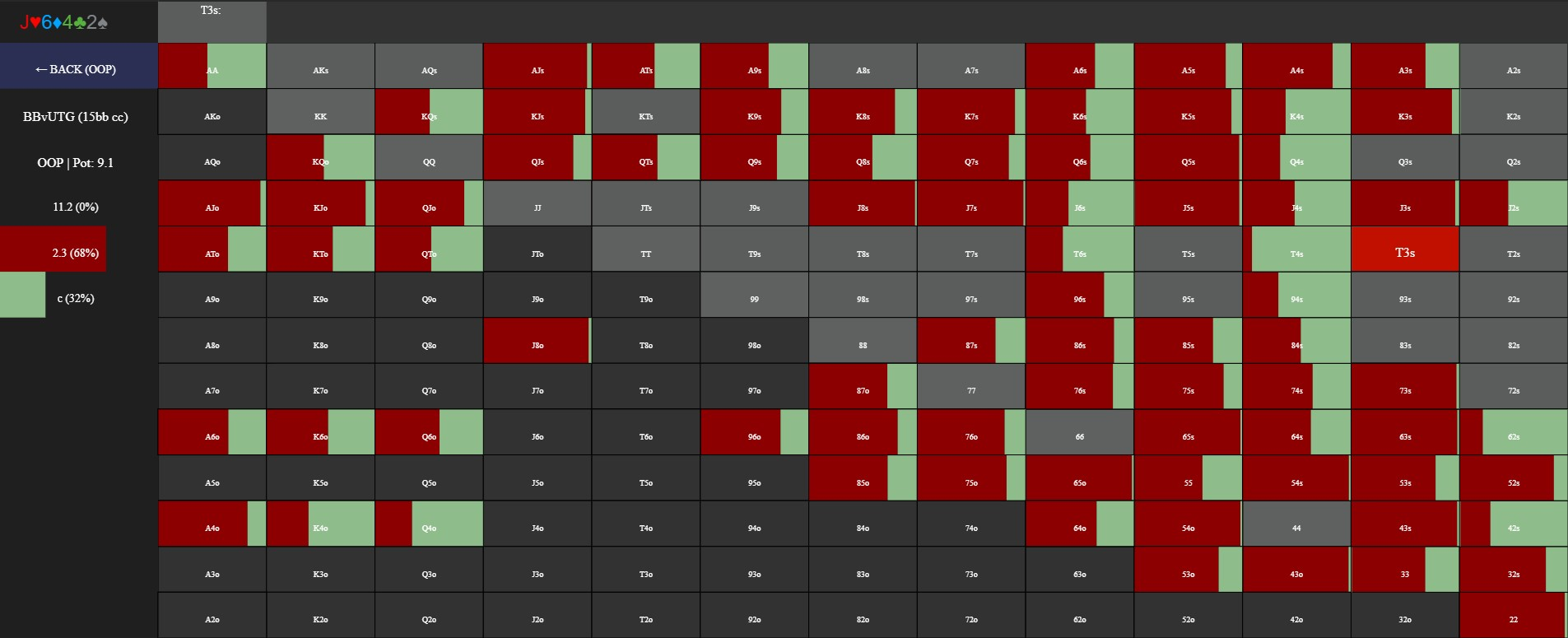
This is certainly where we start to get quite far from what we’re seeing in today’s games.
GTOTrainer wants the BB to develop a very large part of their range for leading 25% in this spot on the 2s turn, leading with around 2/3rds of range. This includes a high frequency of leading with all of our remaining pair hands 4x or higher, our set of deuces, our blockers to the straight such as 73s, as well as many Q, K and A high hands. We can also lead with blocker hands.
Bear in mind that since this is rarely practiced in today’s game, the remainder of the tree would tend to get quite far from what we will generally see at the tables in this spot. This is natural in a game format which still plays so far from GTO and we must bear it in mind as we go on.
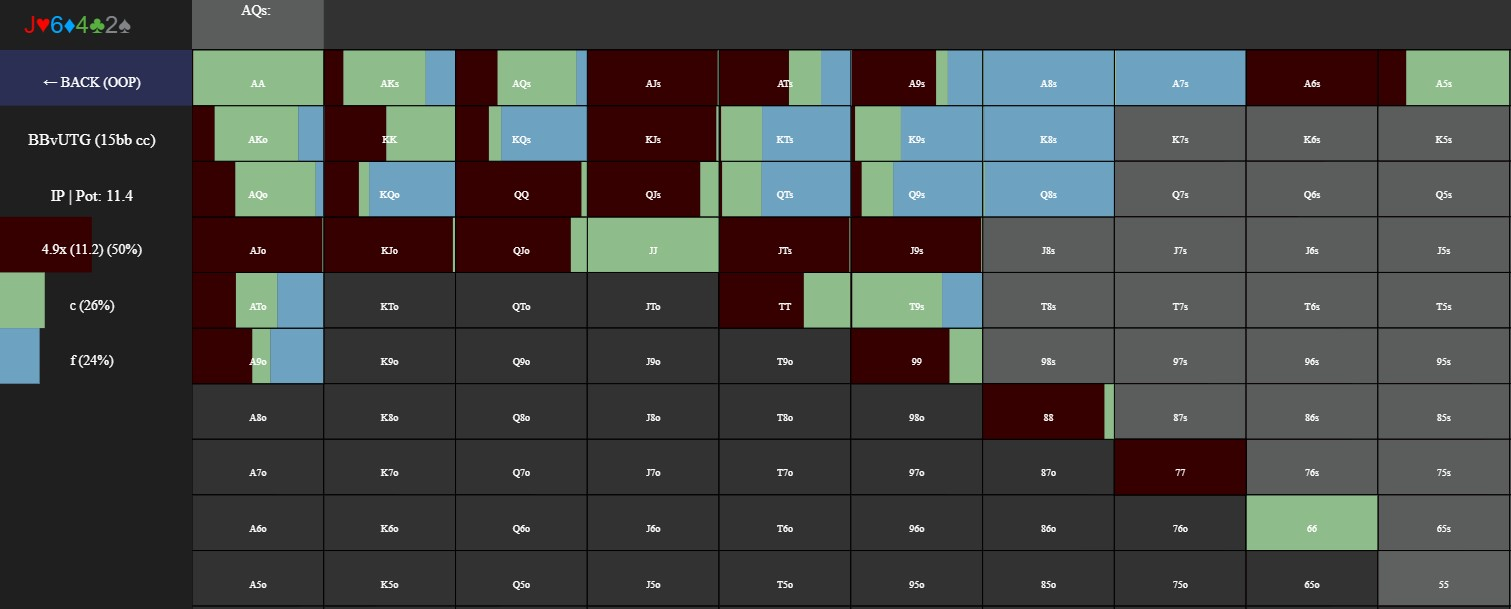
In response to this lead bet UTG is supposed to fold a good amount (24%), as well as just calling with their sets, AA and best A high hands as well as KK and some blocker broadways, but they are supposed to shove half the time, with hands as weak as 77 and A6s.
Would this happen in your games? If not, developing a turn leading range here as BB might work out even better than it does here on paper.
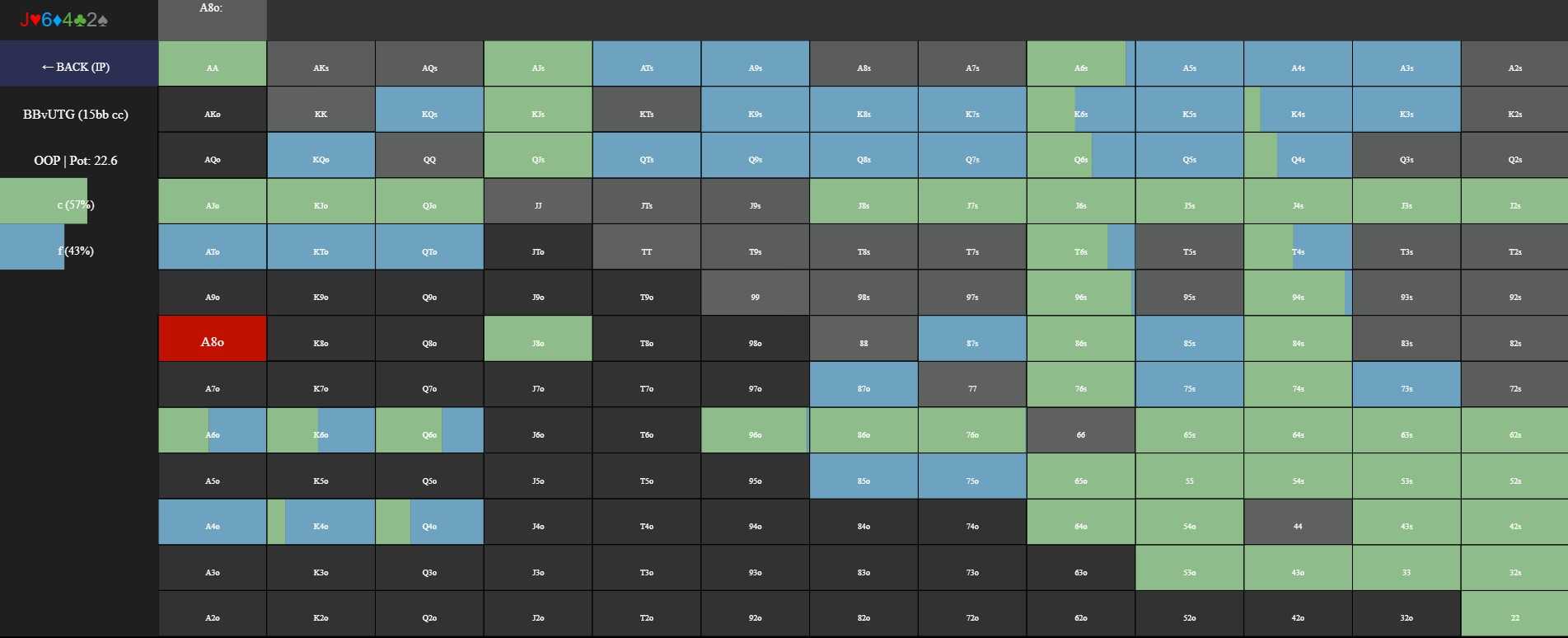
In response to a shove over their lead from UTG, BB is supposed to call off with 57% of their range, including hands as weak as bottom pair with a gutshot (32s, 52s), and is rarely folding any pair, only folding a hand like A4s which also blocks UTG’s best bluff shoves.
Bear in mind of course that if you think UTG is stacking off tighter than the GTO range above, you won’t need to hero call off quite this wide.
BB is supposed to lead such a wide range of hands on the turn that they have a lot of non-pair hands still to fold, meaning they should rarely fold a pair, mostly only a few select 4x and 6x hands which block bluffs.
Let’s take a look finally at how BB would continue a flop check-raise on the same turn card. First, here’s UTG’s response to a BB check-raise of 5bbs:
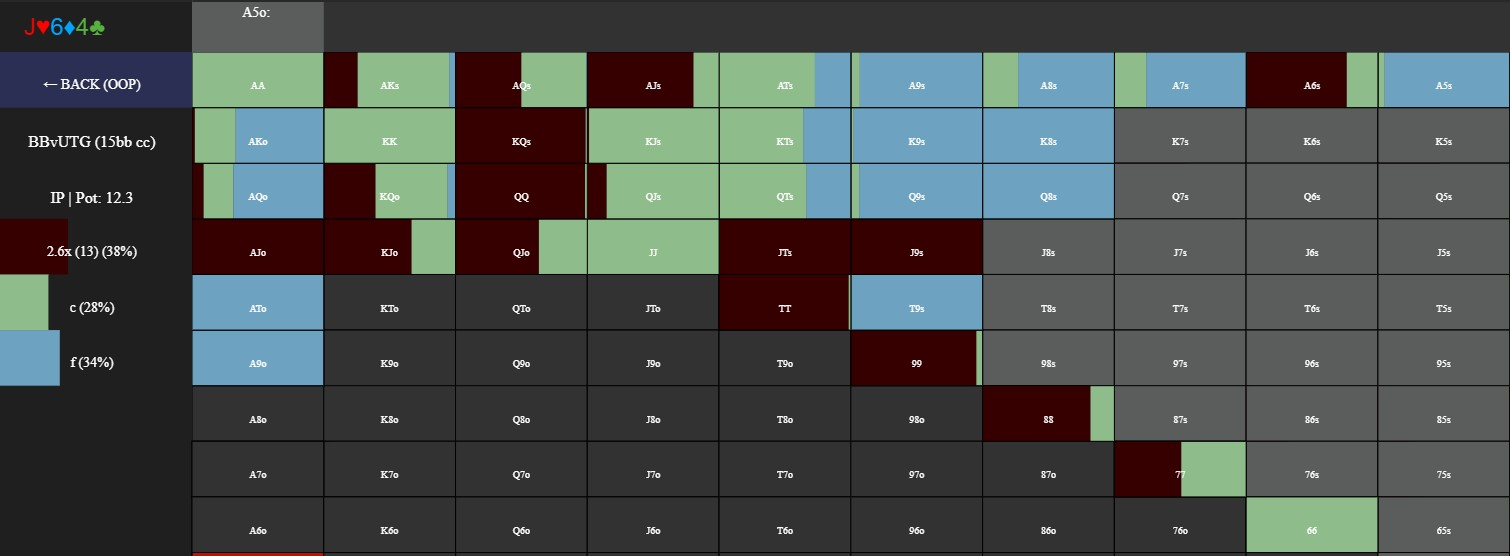
UTG is supposed to stack off here and now with 38% of their range, including hands as weak as KQs, 88 and A6s.
Would they do that in your game? If not, BB might be able to check-raise even more often here despite their equity disadvantage.
UTG is supposed to call a good amount (28%) here including their backdoor straight/flush draws such as KTs and QTs (not spades) whilst folding around a third of the time, including a lot of AKo and AQo type hands.
If UTG shoves, BB is never folding a pair, and is even calling off with a couple of non-pair hands such as 53o (this matrix is not reproduced here).
Finally if UTG flats the check-raise, what hands is BB shoving on the turn? Here’s the lowdown:
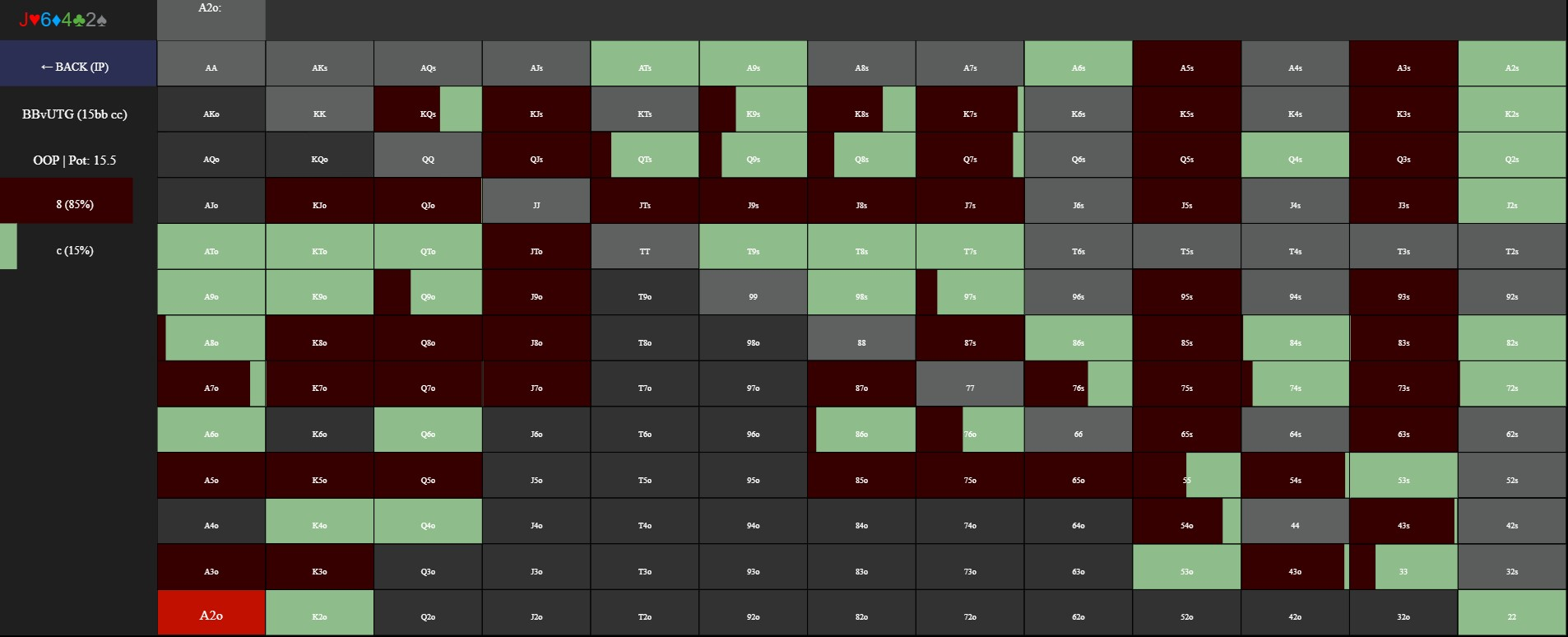
BB is supposed to continue as a shove on the turn with 85% of their range, including numerous pair / draw combos as weak as 43o, blocker hands such as 87o, Q7s and Q5s. There is a wide range of bluff combos here including Q8o, K7o as well as a lot of stronger made hands like QJs and KJs. Bottom set is a check, and we mix checks with some blockers as well as some made hands, particularly 6x and 4x combos.
It certainly appears that Big Blind needs to up their game in MTTs, even in the unenviable position of defending vs a strong range when short-stacked! In general most players are proceeding too cautiously and too passively in these sorts of spots, which is very understandable, but a flawed approach.
Whether it is mixing up your range by leading on the turn, or upping your check-raise frequency on the flop, you likely want to be playing your weaker value hands as well as a good selection of bluffs much more aggressively and also faster than you may currently be doing, at least when playing a board such as this one and facing an active regular
What are your takeaways from this article? What did you find helpful from reading this piece? How do you plan to adjust your game as a result?
We’d love to hear your thoughts as we build out our strategy section, all contributions are welcome, and please also tell us your own findings if you’re already using the software.
Let us know in the comments below, and if it’s really great analysis we might even invite you to become a guest contributor to the site.
If you’re not already using it, you can try GTOTrainer for free, or get a 5% discount on the latest paid PRO or VIP versions of GTOTrainer simply by clicking the button below.
LuckyLuke is offering special rates on his private coaching for all GTOTrainer members - simply hit the coaching link to book a free consult via Skype / Discord.
Happy grinding!